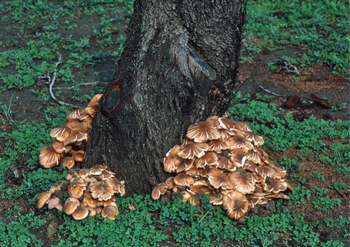Armillaria
-
AboutArmillaria root rot, also known as Oak root fungus, is a disease of many different plants. There is no known effective cure. Root rot fungus disease of trees and woody plants. Affects palms, succulents, ferns and other herbaceous plants like begonia, daffodil, dahlia, and geranium. No known cultivars or varieties of plants that are completely immune. Some plants are very susceptible to the pathogen, e.g., peach (Prunus persica and related Prunus hybrids) and Peruvian pepper (Schinus molle). Infects and kills cambial tissue, causing major roots and the trunk near the ground to die. Can develop slowly, and symptoms may not appear until the fungus is well established. Can persist for decades below ground as mycelium living in partially-decayed woody roots long after the infected host plants have died or were removed.
 Photo: UC ANR
Photo: UC ANR -
Category
-
Fungi
-
-
Signs/Symptoms
Presence of light brown mushrooms which typically appear in a cluster of several to dozens of mushrooms at the base of infected trees or shrubs. Black or dark reddish brown root-like structures (rhizomorphs) are frequently attached to the surface of roots or the root crown. White fan-shaped mycelia, thin, flat sheets of fungal tissue (mycelial fans) that grow just below the bark. Undersized, discolored, and prematurely dropping leaves; branches die, often beginning near the tops of plants. Decline or death of a tree or woody plant; death can occur so rapidly that the leaves turn brown, but don’t yet fall off the tree. Decline may be slower, characterized by dieback of shoot tips over the course of months or even years.
-
Where
Thrives under moist conditions, e.g., when irrigated turf is planted around the roots of California native oaks. Infected through root contact with infected plants or rhizomorphs attached to infected roots. Can survive for many years in dead or living tree roots.
-
WhenN / A
-
Prevent
Provide plants with appropriate cultural care, especially proper irrigation, and adequate drainage. Avoid physical damage to roots, soil compaction in the root zone, and addition of soil on top of the existing grade (especially during construction). Prevent the waterlogging of soils around trees from excessive or inappropriate irrigation, especially in summer. Do not irrigate trees that are mature, established, and have never been irrigated. Remove old roots and debris from the soil before planting. Use pathogen-free plants and air-dry soil well before planting.
-
Manage
Carefully regulate irrigation Immediately correct any over-watering and poor soil drainage. During warm summer months, ensure that the root collar of trees stays dry (i.e., do not set up the sprinkler to hit the base of the trunk). Remove from the nearby landscape any plants that require a lot of water. Overhead sprinkling may reduce the spread because it washes spores off the plant.
-
More Information

